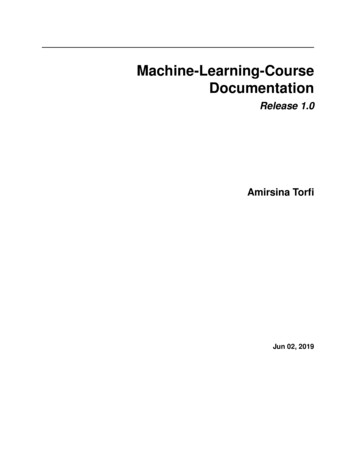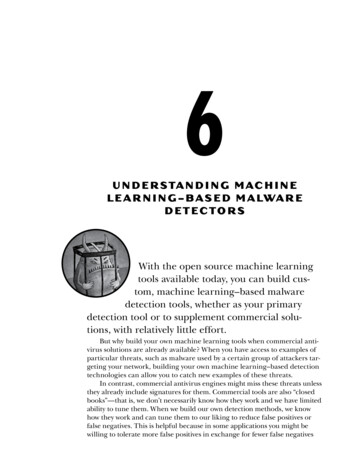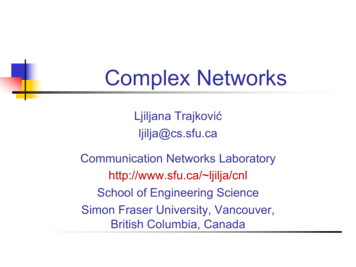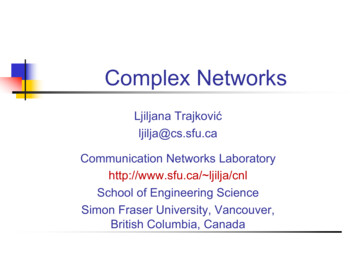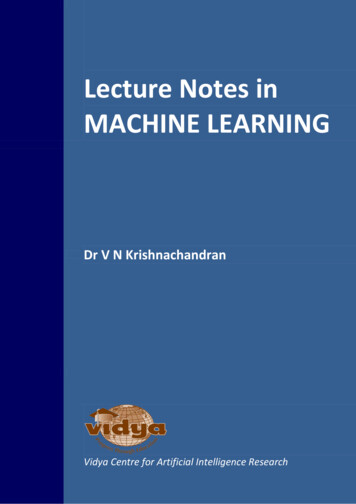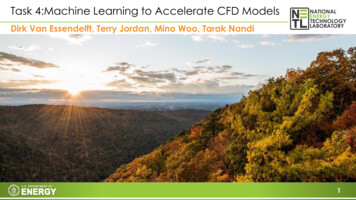
Transcription
Task 4:Machine Learning to Accelerate CFD ModelsDirk Van Essendelft, Terry Jordan, Mino Woo, Tarak Nandi1
Project ObjectiveResearch GoalBuild an advanced collaborative framework specificallytargeted towards CFD on the most advanced HPC/AI hardwarewith native support for AI and ML algorithmsAligned with FE ObjectivesIncreasing computational speed without sacrificing accuracywill directly supports: Modernization of existing coal plantsdevelopment of coal plants of the futureReduction of the cost of carbon capture, utilization, and storage (CCUS)2
Project OriginsDriving Question TensorFlowCan we write MFiX in TensorFlow so that we can create a single, unified framework fordoing both CFD and AI/ML on emerging hardware designed for AI/ML? TensorFlow is the most used AI/ML framework TensorFlow has a simple API and allows for both surface level hardware agnosticcoding and the ability to deeply optimize hardware specific implementations ifneeded Get speed boosts from AI/ML hardware Get speed boost from AI/ML accelerated algorithms Simplify implementation of AI/ML models in MFiXTensorFlow, the TensorFlow logo and any related marks are trademarks of Google Inc.NETL is not endorsed by or affiliated with Google, NETL is sing TensorFlow for its own research in accordance with the TensorFlow license3
Current StatusWhere are we now? In Second Full Year of Development, First year in CARD Ahead of schedule with Milestones EY20.4.A A demonstration of a multidevice linear solver relative to the existing singledevice solver (9/30/2020) EY20.4.B A demonstration of a granular simulations using the TensorFlow basedsolver. (9/30/2020) EY21.4.C A demonstration of a simple fluid bed simulation in the TensorFlow basedsolver. (3/30/2020) Have a functioning, coupled MP-PIC code implemented in TensorFlow Solves all transport equations on available devices followed by a multi-device solveof continuity Ready to accept AI/ML models Does not yet support complex geometries Does not yet support energy, species, or reactionsTensorFlow, the TensorFlow logo and any related marks are trademarks of Google Inc.NETL is not endorsed by or affiliated with Google, NETL is sing TensorFlow for its own research in accordance with the TensorFlow license4
Comparison to State of The artMFIX AI on GPU hardware: MP-PIC SolverTime (s) / SIMPLE Iteration0.250.20.15220 Core1500 CoreEquiv.0.1MFIX Classic CPU10,000 Cells/core0.0500510Millions of Cells15203.8 Million Cells, 16.8 Million Parcels5
Comparison to State of The artMFIX AI on GPU hardware: MP-PIC Solver6MP-PIC Solver Times5439.3x25.2x10010203040Millions of Parcels Per Device503.8 Million Cells, 16.8 Million Parcels6
CFD on Emerging HardwareMFIX (linear Solver) on Joule vs equivalent linear solver on Cerebras CS1Size462 cm2Cores400,000Transistors1.2TMemory BandWidthInterconnectBandwidthcerebras.net9.6 PB/s100 Pb/sMemory18GBPower20kWKamil Rocki, Dirk Van Essendelft, Ilya Sharpov, Robert Schreiber, Michael Morrison, Vladimir Kibardin, Andrey Portnoy, Jean Francois Dietiker, Madhava Syamlal,and Michael James, 'Fast Stencil-Code Computation on a Wafer-Scale Processor', in SC'20 Proceedings of The International Conference for High PerformanceComputing, Networking, Storage, and Analysis (Atlanta, Ga: IEEE Press, 2020).7
Cerebras CS1: Unrivaled SpeedMFIX (linear Solver) on Joule vs equivalent linear solver on Cerebras CS1Speed Limit@ 12k/core100 NodesKamil Rocki, Dirk Van Essendelft, Ilya Sharpov, Robert Schreiber, Michael Morrison, Vladimir Kibardin, Andrey Portnoy, Jean Francois Dietiker, Madhava Syamlal,and Michael James, 'Fast Stencil-Code Computation on a Wafer-Scale Processor', in SC'20 Proceedings of The International Conference for High PerformanceComputing, Networking, Storage, and Analysis (Atlanta, Ga: IEEE Press, 2020).8
Preparing Project for Next StepsMarket Benefits/Assessment While CFD is very powerful design tool, the extremely high computational cost limits itspractical application 9x improvement on PIC, up to 4x on fluid with current gen hardware with TensorFlow 200x on emerging hardwareMakes CFD for optimization and UQ tractableCould open up new application areas in real time or faster than real time CFDTechnology to Market Plan Make incremental releases on the existing MFiX platform so existing MFIX users can pickup and run the tools for their FE supported work Remaining needs: complex geometry, species/energy, reactions Potential New Research: DMP method within TensorFlow, Cerebras CS1 Existing/Potential Collaborators: Industrial relationships with NVIDIA and Cerebras Chris Guenther with TTNEP FWP leveraging frame work with WVU collaboration FOA 2193 - ML models for non-spherical drag9
Concluding RemarksImportant Concepts and Next Steps The most important thing that this project brings is very high levels ofcomputational speed and efficiency without sacrificing accuracy. Means more work gets done in less time and at lower costs Directly translates to reduced uncertainty, design time, cost, and risk for FEapplications Project next steps: Explore DMP method in TensorFlow – could significantly improve scaling Deploy the cut cell methodology for complex geometries Formalize a development plan to take advantage of the unique capabilities on theCS1. Species/Energy, reactions (out years)10
NETL is not endorsed by or affiliated with Google, NETL is sing TensorFlow for its own research in accordance with the TensorFlow license TensorFlow Can we write MFiX in TensorFlow so that we can create a single, unified framework for doing both CFD and AI/ML on emerging hardware designed for AI/ML? TensorFlow is the most used AI/ML framework





